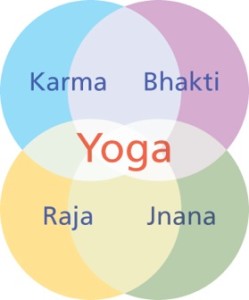Four Paths of Yoga
What are the different styles of Yoga? What type of Yoga are we practicing? What style is this exactly called? What is the difference between Hatha, vinyasa flow, power yoga and the rest? All these are valid questions raised from curious and intrigued yogis in our everyday classes. So let’s address these.
In Yoga, there are four main paths:-
1) Raja Yoga
2) Karma Yoga
3) Bhakti Yoga
4) Jnana Yoga
Raja Yoga is the yoga of self-enquiry, self –knowledge. It is a scientific and systematic approach wherein techniques are used to achieve contemplative knowing, to analyze the mind. This group of teaching is called Royal Yoga or Raja Yoga.
We experience this through Hatha Yoga which is the physical aspect (Asana – the physical movements and postures we practise in a yoga class) along with the breathing techniques or pranayama (which we also practise in a well-rounded yoga class). This helps restore us to our original state which is a state of complete balance, after which self-repair mechanisms start to kick off allowing for optimal bodily regulation. On a deeper level, we get in touch with our core of existence which is the core of all existence.
Over time, Hatha Yoga, and mainly the physical postures has translated and evolved into various styles of practise depending on the pace of movements, style of delivery, surrounding enclosure environments, sequential arrangements of postures being linked with one another, points of views and forms, methods of expression etc. Hence we have various styles being Ashtanga Vinyasa (not to be confused with Patanajali’s Ashtanga or Eight Limbs of Yoga), Iyenger Yoga, Sivanada Yoga, Bikram Yoga, Anusara Yoga, Jivamukti Yoga, ViniYoga, Restorative Yoga, amongst very many still developing others.
The styles are varied, however the physical practise and the breath mindfulness forms Hatha Yoga. So what we practise in our everyday class is Hatha Yoga – the styles being vinyasa, power, flow, ashtanga, prenatal etc.
Karma Yoga involves dedication through selfless service. It encompasses elimination of ego by renouncing the fruits of one’s action thereby making the action selfless. A classic example of a karma yogi is a mother expressing her unconditional love by fulfilling her responsibilities towards a child and very often till the child grows up and old.
Bhakti Yoga talks about pure love and a devotional approach to Yoga. The yogi does not try to rid himself of emotions, instead channels these into sheer devotion. Complete surrender and humility is developed and the ego is dissolved entirely.
Jnana Yoga adopts an intellectual method to spiritual evolution. One must have a sharp and keen intelligence to reason, understand, analyze, and then experience all of the teachings with one’s own intellect. Through study of philosophy, the jnani yogi develops a discriminatory knowledge between the finite and infinite. It is considered to be the most difficult path of Yoga.
The paths may be many, but the Truth is One. Each person must travel his own road to union with the source. For stable and consistent progress, the yogi must choose a -preferred path; however always draw techniques and wisdom from other methods.
—————————————————————————————————————-
Thanks to Zen Yoga for highlighting the same in their August newsletter. Click here to read more.